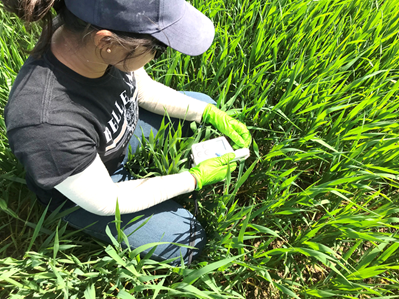Crop lodging is a major problem in staple cereal crops and can cause yield losses of up to 75% in wheat. For her promotion, UT PhD-student Sugandh Chauhan demonstrated a novel remote sensing-based approach to map the susceptibility of certain areas to crop lodging. The results of her work are directly relevant for reaching two targets under the Sustainable Development Goals laid out by the United Nations. Sugandh defended her PhD cum laude.
Lodging is the bending of the stems of cereal crops. When lodged, crops such as wheat become very difficult to harvest. The bending can be caused by both genetics and environmental factors. Lodging deteriorates the grain quality, thus affecting the likelihood of achieving a premium market price. Near real-time information on lodging and its susceptibility can help farmers take measures to prevent the lodging from happening.
Remote sensing
Sugandh investigated the potential of remote sensing data, like satellite imagery, for mapping the lodging susceptibility in wheat. The method she developed can not only be used as an early indicator but also to detect the date the lodging most likely happened. “We found that the lodging susceptibility can be mapped with an accuracy of around 80%”, says Sugandh.

Sugandh collecting data in one the wheat fields
Mapping susceptibility
Her study was carried out on a farm in Italy, where she used data from different satellite sensors, including the Sentinel-1, Sentinel-2 and RADARSAT-2. She mapped the data of almost 600 ha area where winter wheat was sown at the end of October 2017 and harvested at 30 June 2018. One part of her research consisted of using satellite data, to map the safety factor for the entire area between zero and three with areas with values less than one being highly susceptible to lodging and those above one being least susceptible to lodging.
Sustainable Development Goals
Sugandh’s research aligns with the Sustainable Development Goals laid out by the United Nations. Her work is directly applicable for the accomplishment of two targets under Sustainable Development Goal 2: “Zero hunger-Achieve food security and improved nutrition and promote sustainable agriculture”. The next step can be to integrate this research into agricultural monitoring to help mitigate lodging impacts, decrease production costs and increase crop yield and grain quality. “Sugandh’s research is a big step in understanding why lodging occurs”, says her supervisor prof.dr. Andy Nelson.
More information
Sugandh Chauhan was a PhD student in the research group Natural Resources (NRS). Her supervisor was prof. dr. A.D. Nelson from the Faculty of Geo-Information Science and Earth Observation (ITC) and her co-supervisors were Dr. Roshanak Darvishzadeh (also ITC) and Dr. Mirco Boschetti (Institute for electromagnetic sensing of the environment (IREA) in the National Research Council of Italy (CNR)). Sugandh defended her PhD thesis, titled Remote Sensing Of Crop Lodging: A Multi-Sensor Approach, cum laude on 11 November and has created an interactive story map to visualize her research.





